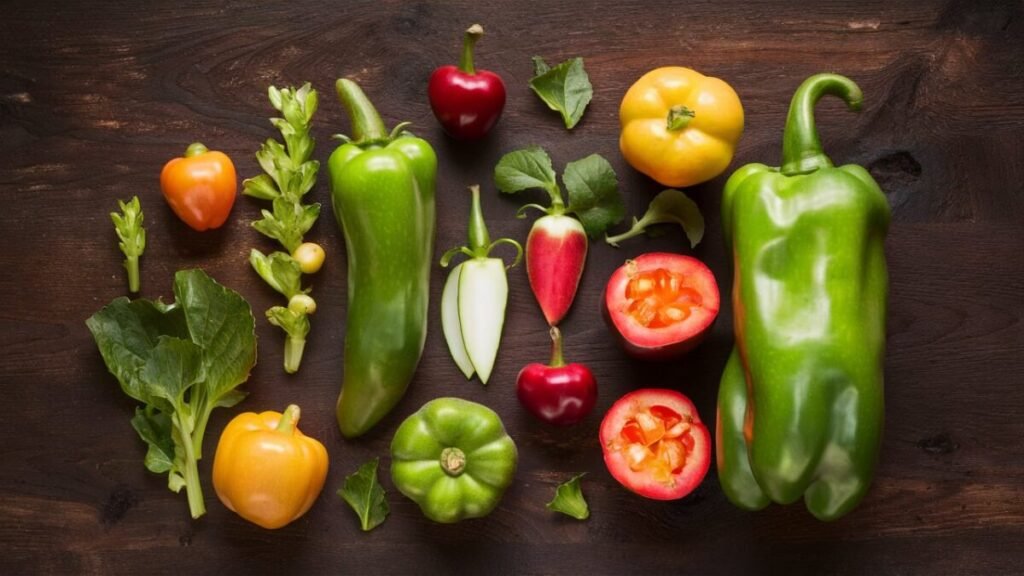Imagine never having to buy fruits and vegetables again – and always having an abundant supply growing right at home.
It’s possible with this brilliant regrowing method!
In this guide on “Regrow Fruits and Vegetables“, you’ll learn the easy steps to regrow 20 common crops from basic kitchen scraps.
Key Takeaways:
- Save money and reduce waste by regrowing fruits/veggies from scraps
- Detailed instructions for regrowing 10 vegetables and 10 fruits
- Tips for providing ideal conditions to ensure regrowing success
- Continual supply of fresh, nutrient-dense homegrown produce
By following these regrowth techniques, you’ll always have fruits and veggies on hand – crucial for survival gardening and self-sufficiency.
Let’s dive into the world of regrowing from kitchen scraps!
Table of Contents
Why Regrow from Scraps?

Regrowing your own fruits and vegetables from kitchen scraps provides numerous benefits for the savvy prepper.
It saves money by allowing you to reuse food scraps instead of buying new seeds or plants.
It guarantees a continuous supply of fresh, nutrient-dense produce. Regrowing also reduces food waste, as you get the most out of every piece of produce.
For many, it’s an engaging hobby and fun activity, especially for kids.
Perhaps most importantly, it gives the immense satisfaction of growing your own food supply.
Check out these rookie gardening mistakes to avoid as a beginner regrowing from scraps.
What You’ll Need To get started regrowing from scraps, you’ll need just a few simple supplies:
- Containers (pots, trays, jars, etc.) with drainage holes
- Quality potting mix or soil enriched with household items for garden fertilizers
- Patience and attentive care
Vegetable Scraps That Regrow

Vegetables are incredibly resilient plants that can be easily regrown from scraps. Here are ten common veggies you can propagate at home:
Potatoes Potatoes are a fantastic survival crop that can regrow from just a few eyes or sprouts on a piece of an old potato. The new plants will produce more potatoes over time. Simply:
- Cut off a chunk with a few eyes
- Let it dry for a day or two
- Plant in soil with the eyes facing up
- Water regularly and harvest new potatoes in a few months
Carrots
The tops of carrot roots can be regrown to produce edible carrot greens and new carrot roots over time. Here’s how:
- Cut off the top 1-2 inches of a carrot root, leaving the top green intact
- Place the top in a shallow dish of water, changing water regularly
- Once roots form, plant the top in soil and continue growing
Celery A single celery base can regrow an entire new bunch of celery stalks. Simply:
- Cut off the base, leaving 2-3 inches attached to the stalks
- Place the base in a shallow dish of water
- Once new leaf growth appears, transplant the base to soil
Lettuce/Greens Lettuce, bok choy, cabbage, and many leafy greens can regrow from just their stem bases. The process is:
- Cut off the bottom 1-2 inches of the stem base
- Place in a shallow water bath until new leaves sprout
- Transplant to soil and continue growing for multiple harvests
Onions The discarded bottom root base of onions can regrow tasty green onion tops. Here’s what to do:
- Cut off the root base, leaving an inch or so of onion attached
- Plant the base in soil with the top exposed
- Water regularly and harvest the greens as they regrow
Ginger
A small nub of old ginger root can sprout a whole new ginger plant! Here are the steps:
- Break off a piece of ginger with a few viable “eyes” or buds
- Plant the piece 1-2 inches deep in warm, moist potting soil
- New sprouts and edible ginger rhizomes will grow over months
Garlic
Individual garlic cloves can be used to grow full garlic bulbs. It’s easy:
- Break apart a head of garlic and plant the individual cloves
- Cover with just 1-2 inches of soil
- Water regularly and new bulbs will develop over months
Sweet Potatoes Just half of an old sweet potato can sprout endless vines of edible leaves and new potatoes. Try this:
- Cut a sweet potato in half lengthwise, burying one half in soil
- Make sure there are a few intact eyes or sprouts on the half
- New vines and potatoes will continuously grow from the buried half
Mushrooms
Believe it or not, you can regrow mushrooms from the stumps left in their growing containers. Simply:
- Leave a 1-inch stub when harvesting mushrooms
- Add a fresh layer of growing medium over the stumps
- New mushrooms will sprout from the stumps in time
Pineapples The leafy tops of pineapples can grow into entirely new pineapple plants, although it takes significant time. Do this:
- Twist off the top few inches of a pineapple crown, leaving some fruit flesh attached
- Allow the crown to dry for a week before planting in soil
- Provide consistent warmth, light, and moisture for 2+ years for fruit
Fruit Scraps That Regrow
Not just veggies – many fruit cores, seeds, and cuttings can also be coaxed into regrowing new plants:
Avocados Those huge avocado pits contain everything needed to grow an avocado tree! Here’s the classic method:
- Wash off an avocado pit and insert 3-4 toothpicks into the pit
- Suspend the pit over a glass of water with the toothpicks resting on the rim
- Once a sturdy stem and roots develop, plant in soil
Citrus The seeds inside oranges, lemons, limes, and other citrus fruits can all be used to grow fruiting citrus trees, with patience:
- Extract some seeds and let them dry out for a week
- Plant several 1-inch deep in potting soil
- Water regularly and transplant seedlings once large enough
Apples Apple cores and even just the seeds can be used to grow apple trees from scratch. Just:
- Remove and thoroughly clean some seeds from an apple
- Plant the seeds 1-inch deep and keep moist
- Transplant any successful seedlings and wait years for fruit
Check out these fast-growing fruit trees if you want a quicker harvest.
Pears
Like apples, pear cores contain all the genetic material to develop into fruiting pear trees. Use this method:
- Extract some pear seeds and let them dry for 2-3 weeks
- Soak the dried seeds in water for several hours before planting
- Plant soaked seeds 1 inch deep and keep consistently watered
Tomatoes The seeds found inside ripe tomatoes can easily sprout new tomato plants if properly planted:
- Slice open a ripe tomato and collect the seeds
- Allow the seeds to dry on a paper towel for a week
- Plant the dried seeds 1/4 inch deep in potting soil
Peppers As a veteran pepper plant, I love sharing how to regrow new pepper crops from kitchen scraps:
- Collect some seeds from ripe peppers and allow to dry fully
- Plant the dried seeds 1/4 inch deep in warm, moist soil
- In 1-4 weeks, new pepper seedlings will emerge to transplant
Pumpkins/Squash Those giant pumpkin and squash seeds found inside are just waiting to be replanted to grow new vines!
- Scoop out the seeds from carving a pumpkin or squash
- Spread seeds on a towel and allow to dry for 1-2 weeks
- Plant the dried seeds 1 inch deep for new pumpkin/squash crops
Mangoes
It’s possible, though tricky, to grow entirely new mango trees from the pits of ripe mangoes:
- Extract a full, healthy mango seed/pit and remove the outer husk
- Plant the pit horizontally just below the soil surface
- Keep soil warm and consistently moist for germination in 3-6 weeks
Passionfruit Those exotic passionfruit seeds are just waiting to sprout new vines loaded with fruit. Simply:
- Scoop out the seeds from a passionfruit and rinse off
- Pat the seeds dry and then wrap loosely in a damp paper towel for 2-3 weeks
- Plant the pre-germinated seeds 1 inch deep and keep moist
Pineapples As mentioned earlier, pineapple tops can be used to grow entirely new pineapple plants that will eventually fruit. Here are the key steps:
- Twist off the top few inches of a pineapple crown, leaving some fruit flesh attached
- Allow the crown to dry for a week before planting in well-draining potting soil
- Provide consistent warmth, bright light, and moisture
- Be patient, as it takes 2-3 years for the plant to mature and produce new pineapple fruit
Tips for Success

Even with hardy fruits and vegetables, a few tips will help ensure success when regrowing from kitchen scraps:
- Provide the right growing conditions – adequate light, water, healthy garden soil, and nutrients
- Exercise patience – some plants like avocados and pineapples take months to sprout and years to fruit
- Transplant seedlings into larger containers as they outgrow their starting pots
- Watch for potential challenges like common plant diseases, pests, or improper conditions
Consider using natural pest killers and plants that repel pests to keep your regrown crops healthy.
With some basic supplies and my 20 years of veggie vigilance experience, you’ll be harvesting bounties regrown from simple kitchen scraps in no time! Follow these methods for a consistent supply of fresh, homegrown produce.
For urban preppers, don’t miss these tips on urban survival gardening and vertical gardening for preppers. You can even start a survival balcony garden!
Regrowing from scraps is just one way to supplement your food supply for personal resiliency.
Also consider planting high-calorie survival crops, fast-growing vegetables, and other essential survival crops for preparedness.


